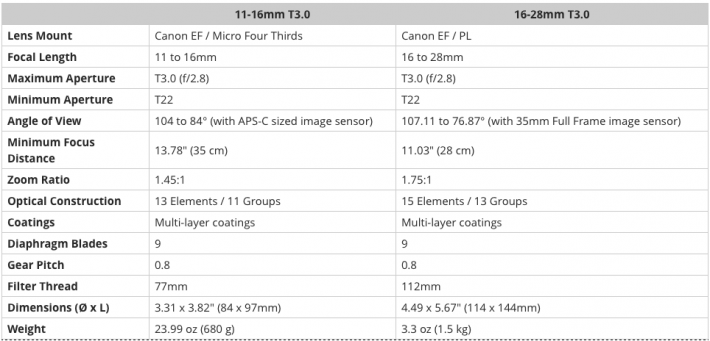Today Tokina released two new ultra wide zooms into their ATX Cinema line of lenses, a 11-16mm T3.0 and a 12-28mm T3.0 (both are modified versions of their popular 11-16mm f/2.8 and 16-28mm f/2.8). Both lenses have click-less aperture rings as well as 0.8 pitch gears on focus, aperture, and zoom rings.
These high-quality optics are targeted at DSLR filmmakers with a need for professional quality features with a small price tag.
The 11-16mm lens is available in Canon EF and MFT mounts and covers MFT, APS-C, and Super-35 sensors. It features two aspherical elements and two SLD (super-l0w dispersion) elements for high contrast, sharp images.

The 16-28mm covers MFT, APS-C, Super-35, and full frame sensors, and is available in Canon EF and PL mounts. This lens has a standard 114mm front diameter which is compatible with most matte boxes and supports LDS (lens data system). It has three aspherical elements and two SLD (super-l0w dispersion) elements as well as a curved 9-blade aperture.

Below is a rundown of the specs from B&H:

[Via B&H Explora]







What technology/features make cinema lenses so much more expensive than photo lenses?
Cinema lenses generally get designed as sets (4/5 or so primes for example) which are designed to be identical in terms of image and use. Physically the notable differences are minimal or no focus breathing through the range, the physical shape and size of primes are identical, the focus and iris ring/gear are in the same place (not having to adjust a follow focus per lens change.
In terms of the image sure you'll have a different T stop range throughout different focal lengths however they are generally matched for colour/contrast etc to give a consistent look - especially grading in post.
Just a few of the many differences between true cinema lenses and photo lenses. Of course there are cheaper adapted 'cine' lenses (Samyang/Rokinon) for example which give a few of the benefits over a photo lens. However they are somewhat pale in comparison (and price!) to the engineering that goes into Schneider/Zeiss/Cooke glass.
The main thing to keep in mind is to use what is best for the job, not necessarily what your wallet can or can't stretch to.
just checked the prices out on BH's website, and damn are they ever appealing. Definitely affordable, compared to most cine lenses!
Hope this is just the beginning for affordable
Cinema zooms! Love my primes, but not for every project. Renting is fine for
paid gigs, but not for my out-of-control personal hobby projects! Can't wait to see some tests on these.
Typo in the 3rd line, 12-28 instead of 16-28.
These lenses are a rip off. Just buy the non-cine, and no Nikon version, so worthless if you have a Blackmagic speedbooster.
The one thing I don't see in any of these lower end lens reviews is whether or not the lens breath when you pull focus. That is a major feature and is the main difference between low end and high end lenses.